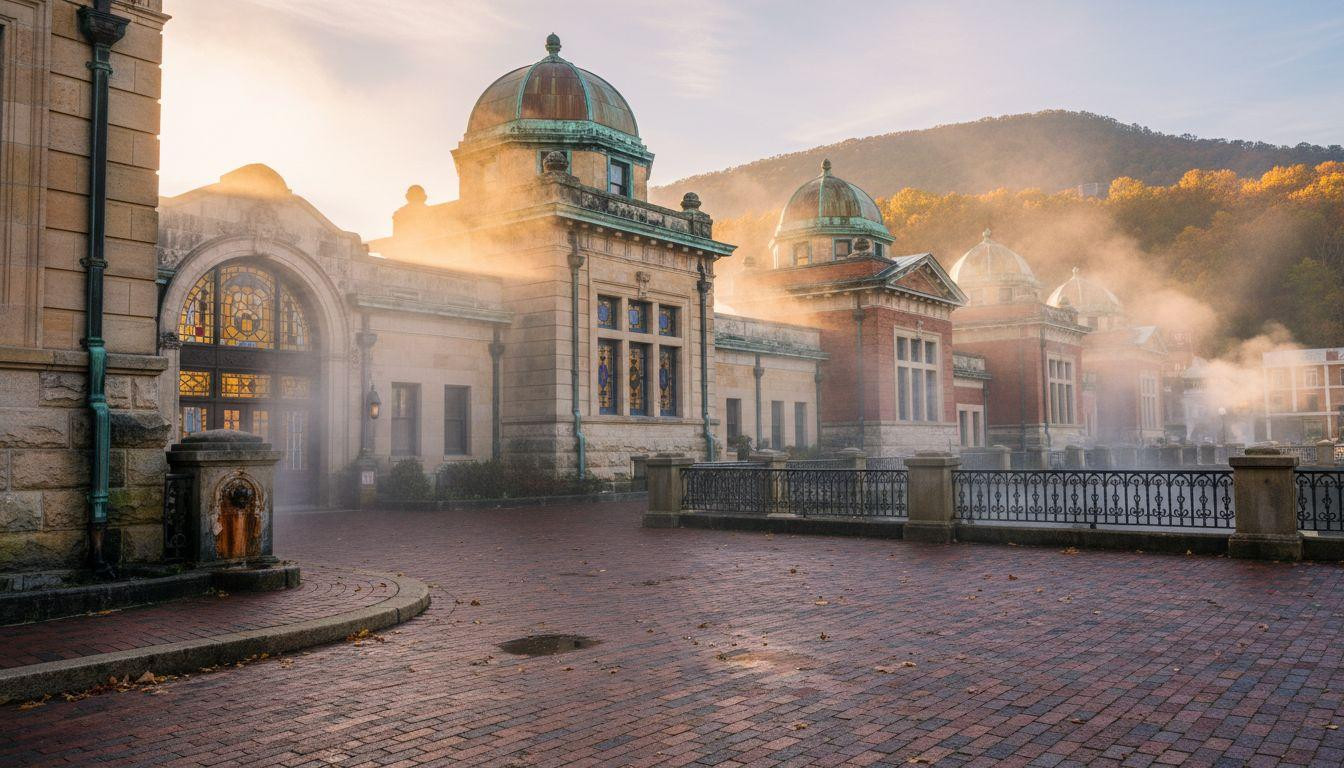Thermal mist rises at dawn from ornate Spanish Colonial bathhouses as 38,000 residents begin their day inside America’s smallest national park. Hot Springs National Park sprawls across just 5,550 acres in Arkansas, where federal wilderness protection meets functioning city life in ways found nowhere else. Here, you can hike 26 miles of Ouachita Mountain trails before lunch, then soak in century-old thermal baths fed by 147°F springs that have bubbled through downtown streets since 1832.
Where national park meets main street
Hot Springs Mountain rises 1,700 feet above Garland County as Arkansas’s only national park contained entirely within city limits. The contradiction defines everything here. Federal wilderness designation protects thermal springs used since Native American times, yet surrounded by functioning neighborhoods, restaurants, and Oaklawn Racing Park.
From Little Rock, the 55-mile drive takes one hour via Highway 70. Ouachita ridgelines emerge before descending into valleys where Victorian storefronts meet Art Deco bathhouse facades. Clinton National Airport connects nationally, with rental cars costing $40-70 daily. This positions Hot Springs as Arkansas’s most accessible mountain sanctuary.
The park boundary begins at Central Avenue, where Bathhouse Row forms the immediate transition between city and park. Unlike traditional national parks with clear perimeters, Hot Springs weaves through established neighborhoods. Capitol Reef’s historic orchards offer similar intimacy between human settlement and federal protection.
The living museum of American spa culture
Bathhouse Row’s golden age architecture
Eight bathhouses constructed between 1912-1923 line Central Avenue in Spanish Colonial Revival, Renaissance Revival, and Beaux-Arts styles. Fordyce Bathhouse showcases ornamental masonry, stained glass skylights, and marble fountain rooms where visitors once “took the waters” for therapeutic healing. The building now serves as the park’s museum and visitor center.
Superior Bathhouse Brewery occupies the 1916 Superior Bathhouse, making it the only brewery inside a national park. Quapaw Baths & Spa operates in its original 1922 building with thermal pools fed by natural springs. This architecture captures 1920s optimism when Hot Springs rivaled European spa destinations.
Thermal springs still flowing
Forty-seven natural springs emerge daily at 700,000 gallons, protected since federal reservation in 1832. This predates Yellowstone by 40 years. Display Springs on Arlington Lawn demonstrates flow through open pools accessible to visitors year-round.
Thermal water reaches 147°F underground, cooling to 143°F at emergence. Like Devils Tower’s unique geology, these springs offer dramatic natural features with 65% lower costs than famous alternatives. Visitors fill jugs at free public fountains throughout downtown, maintaining traditions from 1800s settlement.
Mountains meet bathhouses
26 miles of Ouachita wilderness trails
Grand Promenade brick walkway stretches 1.5 miles, connecting Bathhouse Row to mountain trails through oak-hickory forest. Sunset Trail climbs Hot Springs Mountain to its 1,405-foot summit for panoramic views across Lake Hamilton. Peak Trail ascends Music Mountain through November foliage blazing gold and crimson.
Gulpha Gorge Trail follows creek past 40-foot waterfalls for 2 miles. West Mountain Trail system offers 8 miles of ridgeline hiking with minimal elevation gain. These trails provide immediate wilderness access just steps from downtown, with many residents using them for daily exercise.
Lake country surrounds the city
Lake Hamilton spans 7,200 acres while Lake Catherine covers 1,940 acres, bookending Hot Springs with turquoise waters reflecting forested shores. Fishing for bass, trout, and catfish sustains local culture. Similar to Georgia’s farming towns, authentic Southern culture thrives at half the price of overtouristed destinations.
Garvan Woodland Gardens showcases seasonal floral displays across 210 acres, located 5 miles southeast. Magic Springs Theme Park adds family entertainment alongside natural attractions, with daily admission around $50.
The retro soul persists
Unlike commercialized Gatlinburg or Branson, Hot Springs maintains quiet dignity. Downtown’s neon signs glow softly against Art Deco facades. Local diners serve smoked trout and pecan pie while preserving authentic Southern hospitality.
Oaklawn Park’s winter racing season has drawn regional crowds since 1905 without overwhelming town character. Hot Springs Documentary Film Festival and summer concerts at Magic Springs preserve arts culture. The pace remains unhurried, embodying “slow living” philosophy.
At $60-90 nightly lodging versus $200+ at typical national park gateways, authenticity remains accessible. Like historic Catalan villages, intimate architecture and cultural preservation offer immersive experiences without big-city crowds. November brings 50-75°F days, clear mountain air, and foliage-framed thermal mist rising through golden architecture.
Your Questions About Hot Springs National Park Answered
When should I visit Hot Springs National Park?
Spring (March-May) and fall (September-November) offer ideal 50-75°F temperatures with lower humidity and vibrant foliage. November 2025 hits peak fall colors with crystal-clear mountain days perfect for hiking and thermal bathing. Summer reaches 90°F with higher humidity but lighter crowds. Winter provides quiet solitude with temperatures of 35-55°F.
How much does visiting Hot Springs cost?
National park entry is free. Bathhouse spa treatments cost $50-150 per session. Lodging ranges from $60-90 for budget options, $100-180 mid-range, and $200-350 luxury. Dining averages $10-20 per meal. Total daily budget runs $100-150 per person including lodging, meals, and spa experience.
How does Hot Springs compare to other spa destinations?
Unlike European spa towns or Saratoga Springs NY with higher costs and tourist crowds, Hot Springs combines federal protection, authentic 1920s architecture, mountain wilderness, and Southern affordability. It’s the only U.S. destination offering historic thermal baths inside national park boundaries, maintaining small-town atmosphere versus commercialized resort complexes.
Sunset ignites Hot Springs Mountain Tower as thermal vapors drift through Bathhouse Row’s turrets. This is America’s quietest national park paradox: where wilderness protection meets urban life, where 1920s spa elegance survives in functioning form, where you soak in history between mountain hikes for half the price of famous gateway towns.
